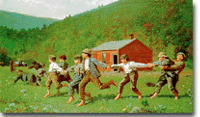38f. Artistic and Literary Trends

Like the American economy, American art and literature flourished during the Gilded Age. The new millionaires desired greatly to furnish their mansions with beautiful things. Consequently, patronage for the American arts was at a higher level than any previous era. Painters depicted a realistic look at the glories and hardships of this new age. Writers used their pens to illustrate life at its best and its worst. The net result was an American Renaissance of arts and letters.
Painting the Gilded Age
Many wealthy Americans yearned to have their image captured for posterity by having their portraits painted. James McNeill Whistler and John Singer Sargent were the most sought after portrait artists of the time. Lured by the idea of working among European masters, both moved to England. Their works endure as among the finest in the genre. Another expatriate American was the impressionist Mary Cassatt, who moved to Paris to work with the masters Monet and Renoir. Beyond any artist of the age, she captured women and children at their tender best.
Perhaps the most famous of the postwar American painters was Winslow Homer. Homer gained fame during the Civil War for his realistic illustrations of Union soldiers, which often graced the covers of Harper's Weekly magazine. After the war he became a serious painter. Life in the American countryside was made real to those who flocked to the cities. His later years were marked with a fascination of the New England coast. Probably no American painter captured the majesty and power of the sea like Homer.
At the same time, Philadelphian Thomas Eakins illustrated local behaviors, including a series depicting crew races on the Schuylkill River. His most controversial work, The Gross Clinic, depicted a live medical operation.
Literature
In literature, the dominant figure of the age was Mark Twain. Born Samuel Langhorne Clemens, Twain spurned the stodgy New England writing style of the time and brought an added touch of realism by writing in the local color and style of the American Mississippi. Huckleberry Finn and Tom Sawyer became genuine American folk heroes to his many readers.
Kate Chopin was largely unknown at the time, but her novel The Awakening became a manifesto for future feminists. Stephen Crane portrayed the horrors of the Civil War with his poignant The Red Badge of Courage in 1895. Henry James struggled with the values of the Victorian Age by focusing his attention on women. His works Daisy Miller and Portrait of a Lady hinted at the tension lying beneath Victorian morality. The horrors of city life were grimly depicted in Theodore Dreiser's Sister Carrie, whose representation of a poor working girl offended many a reader.
Postwar poets were prolific. Most notable were Walt Whitman for his Leaves of Grass collection and Emily Dickinson, whose many poems were published after her death.
In the Home
The visual arts flowered as well. The market for interior design was booming. Louis Comfort Tiffany specialized in stained glass. He combined glorious colors of glass with shells and stones to create beautiful works for fine homes. He was even commissioned to improve the interior of the White House. Candace Wheeler pioneered work in tapestry weaving. Wealthy Americans bought these items with a fever, and lavished their homes with marble floors and decorative chandeliers. The American Renaissance was in full swing.






